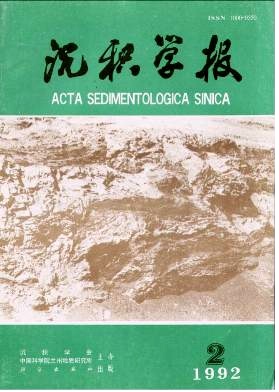Rice-shaped Dolomite and Its Exsolution Origin
- Received Date: 1990-06-30
- Publish Date: 1992-06-10
Abstract: Rice- shaped dolomite crystals exist in dolomite- patched micritic, biomicritic, intraclastic andstrornatolitic limestones in an Ordovician nearshore, carbonate succession, reaching their highest concen-trations promixal to worm burrows and pore space between intraclasts. The crystals are elongaterhombohedra and appear to be elongate hexagons, parallelograms or trapezoids and look like rice grains inthin sections. No internal zoning or foggy cores are present but numc;rous minute calcite "enclusions" distrib-ute parallel to the boundary of the crystals. The C-axis is perpendicular to the longer boundary of the crystalIt contains higher Fe, Mn, Na and Ba than surrounding calcite micrite which contains a greater proportion of Sr, especially its Fe and Ba are tens of times higher than those of calcite. C-axis orientation negatesthe dolomite representing replacement of gypsum.It can not be ureated by an ordinary dolomitization or thereplacement of norsethite and is suggested to form in a process that the precipitated magnesian calcite.is recrystallized into its inherent crystallographic shape, then followed by exsolution accompanied by ex-change of calcium for magnesium ions under conditions of increased pressure. The agent triggering therecrystallization of magnesian calcite is probablyinpenecontamporaueous of early diagenetie interstitial wat er with high Mg/‘Ca ratio, in which there may be some substance that can release chemical energy not on、to dehydrate Mg2+ but also to order the entering of the ions into lattice. As the water solution permeates thesediments downward and upper layers are dolomitized, the substance (or its energel is consumed gridnally, the concentration of which could become as less as can only carry out dehydration of Ioci1 ion, but cat not make the activity of the cans ordered whrn the solution reaches the lower livers, As a result, parts,mignesian calcite in the lower sediments ire favoured to grow up trir;sforming W their inheren}rvstallographic shape. Some $a compound seems to be a candidate 1-or the substance
| Citation: | Wu Jinhua, Philip Fralick. Rice-shaped Dolomite and Its Exsolution Origin[J]. Acta Sedimentologica Sinica, 1992, 10(2): 45-53. |






 DownLoad:
DownLoad: